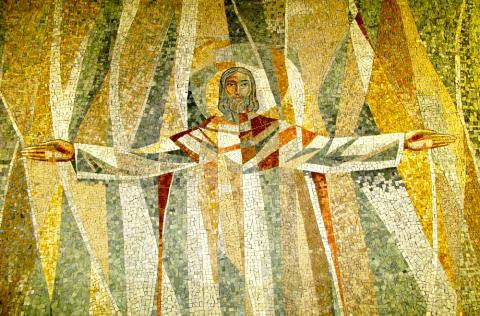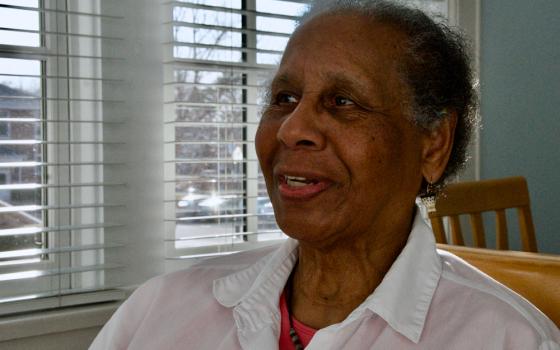
Who knows where the singing has gone? (Joan Sauro)
The choir is a haphazard collection of 20 sisters of a certain age. Some can sing, others have never tried, but hope by dint of effort to learn. They have practiced for six months and this night they are spread out in three rows before the altar in the packed chapel. To their right is a drummer, to their left, a pianist. Behind them a pair of crutches and three canes lie out of sight, out of mind.
The director is tall, thin, and white-haired, with long arms and fingers that flutter like birds' wings over the heads of the singing sisters. Her hands weave three strands of song until the whole ensemble lifts, and falls, soars and softens. Her fluttering fingers play the air, until the whole takes flight as sisters sing and birds fly. They even reach up to the mosaic of the resurrected Christ on the wall behind the singers.
Midpoint, the director gestures to the soloist in the back row. This sister is a tall, dark haired beauty whose operatic voice makes the stained glass windows tremble. And every heart in the pew, as well. Up above her the mosaic of the resurrected Christ blesses with arms outstretched. His face seems amazed.
You raise me up, so I can stand on mountains.
You raise me up to stand on stormy seas.
At this the whole congregation rises to its feet, each face beaming, no matter the stormy seas. The voice is rapturous, out of this world, so that even the lips of Christ smile because nothing is set in stone, not joy, not tears, not yesterday and, certainly, not tomorrow. Sing, sisters, sing.
How can any photographer capture all of this? Much less a photographer with scleroderma. This sister has lost her fingers to the second joint and her left leg, but she is undeterred. Holding her camera with broken hands, pacing back and forth with one prosthetic leg, she makes sure not one single sister goes unnoticed, this day when sisters sing.

"The All-Embracing Love of the Resurrected Christ" mosaic (Courtesy of Mary Rose Noonan)
My companion and I have traveled three hours to join our friends who have reserved front row seats in the crowded chapel. We sit and rise and clap and cheer, one song after another.
Early on, the photographer bows to the choir, turns to see a crowded chapel and no vacant seats. I ask my companions to move a little, stretch my left arm across the back of our pew and wave the photographer over.
She enters, sits down and promptly lays her head on my left shoulder. I wrap my left arm around her and there we sit, in the front row of the packed chapel.
Make no mistake, I am no Christ figure with a friend leaning on her chest. This is no Holy Thursday moment. It portends Good Friday. But no one can foresee that. Better to wrap arms around each other today and listen as sisters sing.
Then I am still, and wait here in the silence.
Until you come and sit awhile with me.
Advertisement
Who can foresee that in less than two years, on Good Friday itself, the photographer's remaining leg will be amputated above the knee.
Who can foresee that in less than two years the soloist will not sing, will not stand on mountains but lie mute on an operating table while surgeons break her sternum and remove her heart. They will repair her mitral and tricuspid valves, perform a cardiac ablation, and then put her heart back in her body.
Who knows where the singing has gone? Not the surgeons, you can be sure. They find much to repair but would have to look in vain for the singing box. Sad to say, the soloist herself cannot find the music. She tires easily now and has to deal with a pacemaker.
Maybe the singing is back in the chapel, the vibrations in the very walls. Maybe the singing is in the stained glass windows, the crescendo and decrescendo of colors. Maybe the singing is in the hearts of those who sit quietly there.
And maybe we carried the singing right out of that chapel and brought it home with us. Maybe the singing is in the arms we wrap around each other. Today, and every tomorrow.

Maybe the singing is in the arms we wrap around each other. (Joan Sauro)






